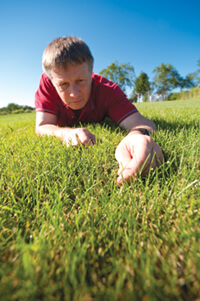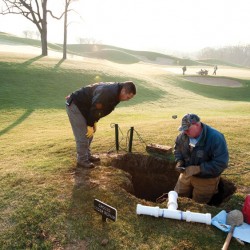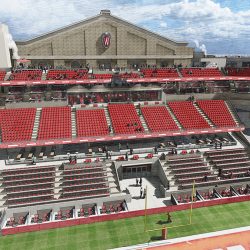On Home Turf
Horticulture prof is in his element when working with sports venues around the world.

John Stier says Wisconsin — which truly has four seasons — is an ideal place to study turfgrass science. Photo: Bryce Richter
John Stier spends much of his career on hallowed ground, his skills in demand at places such as Lambeau Field in Green Bay and Real Madrid’s home stadium.
Stier is not a multi-sport athlete; he’s a UW horticulture professor who leads one of the best turfgrass science programs in the country.
He got his start somewhat by accident. At Ohio State University, he enrolled in a turfgrass pathology class when the course he originally wanted to take was full. Stier earned the only A and went on to work for the professor.
Then Michigan State University recruited Stier to develop a portable indoor turf system for the Pontiac Silverdome for the 1994 World Cup, hoping to capitalize on his knowledge of turfgrass diseases.
“In an enclosed environment where there’s very little light, very little air movement, diseases can wipe out a turfgrass system pretty quick,” he says. “We were doing something that nobody else had ever done.”
Stier met with the president of the Fédération Internationale de Football Association (FIFA, the governing body of international soccer) and others from around the world to plan for the World Cup. After traveling to England to view soccer venues such as Wembley Stadium, he says, “It really began to sink in that this is a great ticket for a career that has some international opportunities.”
Stier came to the UW in 1997 and found that Wisconsin’s varied weather patterns make it an ideal place to study turfgrass science.
“We get true winters. We get true summers. We get springs and falls,” Stier says. “We get unexpected rain events … which oftentimes offer serendipitous observations.”
High schools and colleges that have field problems, such as dying grass, benefit from Stier’s advice, too. “It almost always boils down to poor drainage, because the people building the field didn’t understand how to build the field,” he says.
Turfgrass is not a new field of study. The rising popularity of golf prompted Penn State University to hire the first faculty member in turfgrass science in the 1930s, and the U.S. Department of Agriculture employed researchers in the area as far back as 1910. Now turfgrass science programs can be found at most land grant universities in the country, and many graduates find lucrative work as golf course superintendents, Stier says.
Today’s sports fields are “head and shoulders” above those of twenty to thirty years ago, Stier says. Fewer players get injured on better playing surfaces that offer solid footing, making the field less of a factor in a game. Turfgrass researchers made that happen by investigating drainage properties of different soil types, novel grasses to use, and better ways to manage grass, he says.
But Stier also learns a lot from people who are not scientists: those who take care of the grass every day at high-profile venues such as Lambeau Field and Miller Park.
“It’s not a job to them — it is a lifestyle,” he says. “They live, eat, and breathe it.”
Published in the Fall 2010 issue



Comments
Giovani November 3, 2010
It is impressive that Mr. Stier got to experience time on some the worlds most notorious stadiums for having fantastic playing fields like the Bernabeu in Madrid and the Legendary Wembley!